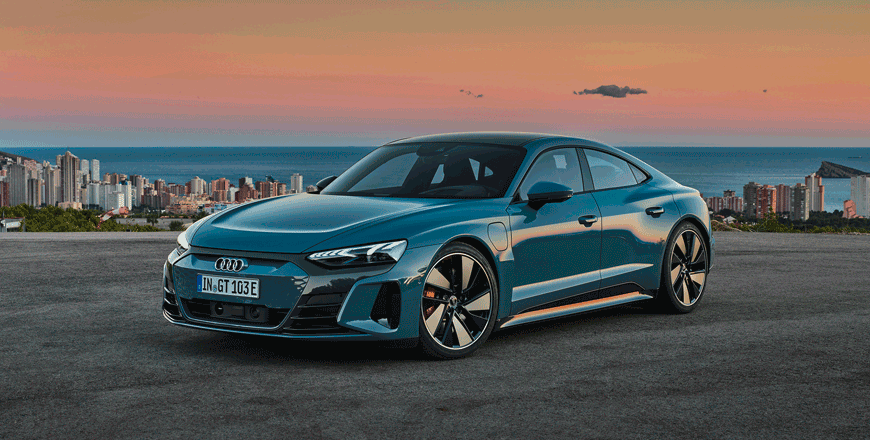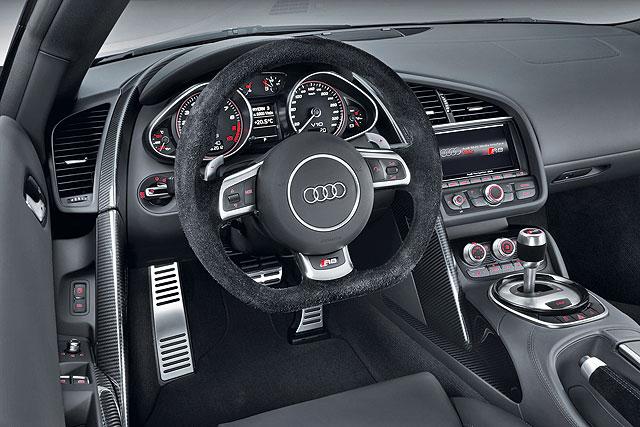You are here
Audi R8: Ingolstadt’s best races into the sunset
By Ghaith Madadha - May 22,2023 - Last updated at May 22,2023

Photo courtesy of Audi
Even on the eve of its demise by year’s end as Audi barrels along into a fully electric future, the R8 remains the singularly most exciting and iconic car since the German brand’s defining 1980-91 Quattro model. Likely be replaced by some hyper powerful sports car towards the end of the decade while the low-slung Audi E-tron GT electric super saloon keeps the flagship sports car seat warm in the meantime, neither can be expected to hold a candle to the soon departing R8 in dynamic finesse, visceral connectivity and authenticity.
While Audi have experimented with an electric variant in the form of the limited 100-car R8 E-tron of 2015, the R8 was nevertheless a dedicated mid-engine two-seat supercar powered by large high-revving naturally-aspirated combustion engines since inception. First released in 2006 as a more practical, subtle and discreet “grown up” alternative sister to Audi-owned Lamborghini models, the original R8 was based on the Lamborghini Gallardo. The second and still current generation R8 then arrived in 2015, sharing the same platform and engine as the new Lamborghini Huracan.
Evocative evolution
A faster, better handling and more comfortable and practical successor, the sensational second generation R8 is evolutionary in design, engineering and character. Little changed in size, it is lighter, stiffer and incorporates more aluminium and carbon-fibre content in its spaceframe construction and body. With a level waistline and broad footprint emphasising its Quattro four-wheel-drive, the successor R8 is a tauter, tidier, sharper and more predatory interpretation that gained a broader, taller single-frame hexagonal honeycomb grille flanked by side inlets and sharp, squinting headlights.
With a low ridged and rising bonnet, forward-set cabin and arcing roofline, the R8 carries itself with a sense of urgency, while its trademark vertical carbon-fibre “sideblades” serve as covers for the side intakes feeding its mid-mounted engine with air, and at the same time emphasising its broad shoulders, flowing lines and ground hugging stance. With a minor face-lift to see it through to end of production, the R8 gained a sharper front bumper treatment in 2019, with a yet bigger grille with slim inlets above, and it full width rear fascia honeycomb mesh.
Quick charisma
Sharing much with its Lamborghini sister including a gloriously rev-hungry naturally-aspirated engine, the R8’s charismatic and driver-engaging dry ump 5.2-litre V10 came in two versions, with the top R8 V10 Plus specification being rebranded as the R8 V10 Performance. Ostensibly gaining 10BHP, 15lb/ft torque and 0.1-second quicker acceleration, the R8 V10 Performance, however, seems to still be offered in some regional markets with little altered performance from the last driven R8 V10 Plus variant, as featured here as a representative example for a send-off review of Audi’s greatest modern road car.
Visceral and sensational in headline figures and real world driving, the 8,700rpm-capable V10 Plus develops 602BHP at 8,250rpm and 413lb/ft at 6,500rpm. Ripping through 0-100km/h in 3.2-seconds or less, 0-200km/h in 9.9-seconds and onto 330km/h, it is ultra-responsive to the slightest input as it pulls hard from idling through to mid-range, as it builds torque and power with urgently searing progression. Similarly responsive whether revving or winding down, it provides exacting throttle control for intuitive driving, and for dialling in exact increments of power to intuitively finesse grip, slip and ‘at the limit’ handling.
Connected yet committed
With its ferociously progressive delivery, the R8 V10 Plus allows far greater, more delicate and precise control for on-throttle handling than the unrefined sledgehammer brutality of a powerful electric motor, which tends to inopportunely unstick the driven wheels and inadvertently invoke intrusive electronic controls. The V10 Plus’ seamlessly swift shifting 7-speed dual-clutch gearbox meanwhile allows one to experience the full extent of its peaky rev range at different speeds, and continue accelerating with a relentlessness unlike that of typical single-speed electric vehicle transmission systems.
Bolting from standstill with all wheels digging into tarmac, the V10 Plus’ authentic, soul-stirringly visceral soundtrack is a throaty, raspy and distinctly metallic staccato that crackles and hardens to an urgent bellowing and wailing as revs rise viciously, and is unmatched by the E-tron GT’s synthesised noises, or any EV successor. Urgently indefatigable against wind resistance, the V10 Plus develops up to 140kg downforce at speed for stability and steering control. Meanwhile, optional adaptive magnetic dampers provide a supple, fluent and settled ride over fast straights and imperfect textures, and conversely taut cornering body control through switchbacks.
Comfort and clarity
Significantly lighter than the E-tron GT, the 1,580kg R8 V10 Plus is agile yet committed through corners, with rear-biased four-wheel-drive and low within-wheelbase weighting making it neutral and nimble through corners. Its direct, well-weighted electric-assisted steering meanwhile delivers a quick, crisp turn-in. With stability controls in low intervention mode, the V10 Plus can obligingly but slightly kick the rear out to tighten cornering lines, as its four-wheel-drive and limited slip differential quickly redistribute more power frontward and along the rear axle for more traction before blast out onto a straight. Scalpel sharp through hill climbs, it is connected, agile and engaging, yet develops plenty of road-holding when needed.
Capable yet flattering, the R8 V10 Plus is a more practical, attainable and understated daily supercar than its more exotic Lamborghini relation. Where the R8 excels is in its accessible, luxurious, well-equipped and spacious cabin, with useable luggage room, generous headroom and excellent visibility, including even better rear visibility than some front-engine sports cars. Its superb driving position, visibility and user-friendly manual mode steering-mounted gearbox paddle shifters meanwhile make one feel at the centre of action, and add a crucial level of confidence, control and clarity at speed, through switchbacks and in the city.
TECHNICAL SPECIFICATIONS
Engine: 5.2-litre, mid-mounted, dry sump, V10-cylinders
Bore x stroke: 84.5 x 92.8mm
Compression ratio: 12.5:1
Valve-train: 40-valve, DOHC, direct injection
Gearbox: 7-speed automated dual clutch
Driveline: Four-wheel-drive, multi-plate clutch, limited-slip differential
Gear ratios: 1st 3.133; 2nd 2.588; 3rd 1.958; 4th 1.244; 5th 0.979; 6th 0.976; 7th 0.841; R 2.647
Power, BHP (PS) [kW]: 602 (610) [449] @8,250rpm
Specific power: 115.7BHP/litre
Power-to-weight, unladen: 381BHP/tonne
Torque, lb/ft (Nm): 413 (560) @6,500rpm
Specific torque: 107.6Nm/litre
Torque-to-weight, unladen: 354.4Nm/tonne
Rev limit: 8,700rpm
0-100km/h: 3.2-seconds
0-200km/h: 9.9-seconds
Top speed: 330km/h
Fuel consumption, combined: 12.3-litres/100km
CO2 emissions, combined: 287g/km
Fuel capacity: 73-litres
Wheelbase: 2,650mm
Track, F/R: 1,638/1,599mm
Overhangs, F/R: 994/782mm
Unladen/kerb weight: 1,580kg/1,655kg
Weight distribution, F/R: 42 per cent/58 per cent
Luggage capacity, boot/behind front seats: 112-/226-litres
Steering: Electric-assisted rack & pinion
Turning circle: 11.2-metres
Suspension: Double wishbones, adaptive magnetic dampers
Brakes, F/R: Ventilated, perforated ceramic discs
Brake calipers, F/R: 6-/4-piston calipers
Tyres: 245/30ZR20/305/30ZR20
Related Articles
The Ingolstadt automaker’s first fully electric vehicle (EV), the Audi E-tron just might be the most well-rounded production EV.
A late coming competitor to the Tesla Model S ubiquitous to the sporting coupe-like low-roof EV executive saloon segment, the Audi E-Tron GT
Well received when first launched in 2007 as a V8 engine premium luxury sports car, it was only a matter of time that the R8 was fitted with the same V10 engine powering Audi subsidiary Lamborghini’s most prolific and now defunct Gallardo.














